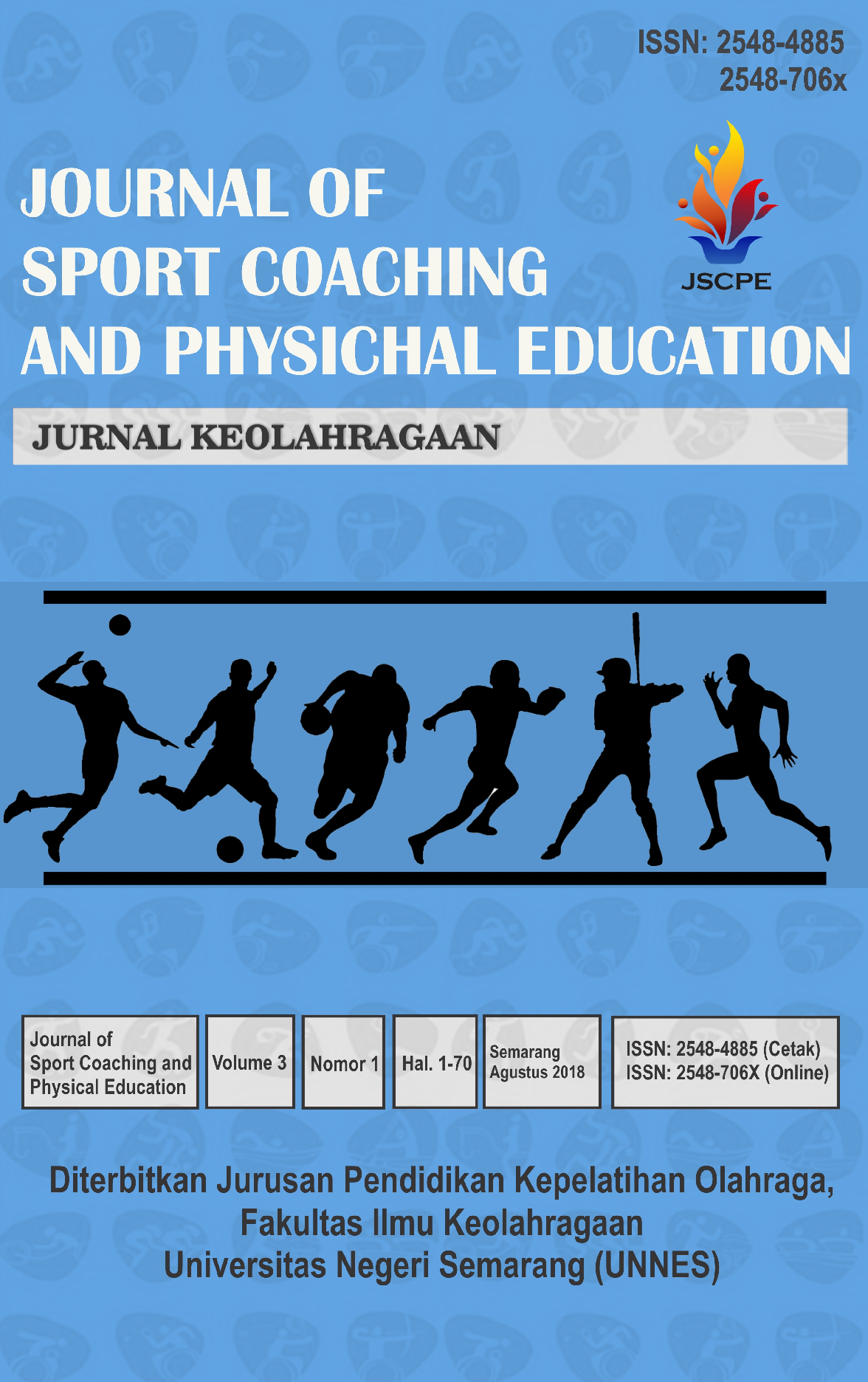PENGARUH PENDEKATAN PEMBELAJARAN DAN KOORDINASI MATA TANGAN TERHADAP KETERAMPILAN PUKULAN FOREHAND DRIVE TENIS MEJA PADA SISWA SMK NEGERI 3 KUDUS
##plugins.themes.academic_pro.article.main##
Abstract
The purpose of this research is to know about: 1) The difference of influence between massed practice and distributed practice approach to forehand skill of table tennis drive. 2) Differences of forehand skill of a table tennis drive between students who have high hand eye coordination and low eye eye coordination. 3) There is an interaction of the learning approach and hand eye coordination to the forehand skills of a table tennis drive. The design of this research is 2x2 factorial. The sample used in this research is 40 students, which is obtained by purposive random sampling technique. The variables in this study consist of 2 independent variables, namely: 1) manipulative variables consisting of massed practice learning approach and distributed practice learning approach. 2) attributive variable consisting of high and low hand eye coordination. One dependent variable is the forehand skill of a table tennis drive. The techniques and instruments of data collection in this study used tennis ball throw test to measure hand eye coordination.
##plugins.themes.academic_pro.article.details##
References
Arikunto, S. 2002. Prosedur Penelitian. Jakarta: PT. Rineka Cipta.
Arikunto, S. 2006. Prosedur Penelitian Suatu Pendekatan Praktik. Yogyakarta: Rineka Cipta.
Baumgartner, Ted A., Jackson, Andrew S., and Mahar, David A. 2003. Measurement for Evaluation in Physical Education and Exercise Science. Boston: McGraw-Hill.
Bompa, Tudor O. 1999. Periodization training for sport. Auckland New Zealand: Champaign Human Illinois
Borg W.R, and Gall, M.D. 1983. Educational research: An Introduction. 4th ed. London: Longman inc.
Budiwanto. S. Human Kinetics. 2004. Pengetahuan Dasar Melatih Olahraga. Malang: Jurusan Ilmu Keolahragaan FIP UM Universitas Negeri Malang
Drowatzky, John N. 1981. Motor Learning Principles and Practices. Minnesota: Burgess Publishing Company
Dunvy, M. Wilde, R. Volleyball Today Canada, Wadsworth: a division of Thompson Learning. Pub, 2000.
Fox, Edward. 1983. Sports Physiology. Ohio: The Ohio State University.
Fox, Edward L, Bowers, Richard W, Foss, Merle L. 1993. The Physiological Basis For Exercises and Sport Iowa:Madison Winconsin Dubuque.
Harsono, 1988. Coaching dan Aspek-Aspek dalam Coaching. Jakarta : P2LPTK.
Hidayat, Imam. Biomekanika. Bandung:FPOK UPI Bandung.
http://www.ittf.com/ittf_ranking/. (diunduh 18 Maret 2015).
Isaac, Stephen., Michael, William B. 1981. Handbook in Research and Evaluation. San diego: Edits Publishers
Maggil, Richard A. 1980. Motor Learning Concepts and Applications. Lousiana State University: Brown and Benchmark
Maksum, Ali. 2009. Metodologi Penelitian Dalam Olahraga. Surabaya: Fakultas Ilmu Keolahragaan Universitas Negeri Surabaya
McGinnis, P. 2005. Biomechanics of Sports and Exercises. Canada:Human kinetics
Moleong, J. L. 2005. Metodologi Penelitian Kualitatif. Bandung: PT. Remaja Rosdakarya.
Sudjana. 1990. Penilaian Hasil Proses Belajar Mengajar. Bandung. Remaja Rosdakarya.
Sudijono, Anas. 1987. Pengantar Statistik Pendidikan. Jakarta: CV Rajawali
Sugiyono. 2005. Memahami Penelitian Kualitatif. Bandung: Alfabeta
Suharno, 1993. Metodologi Pelatihan. Jakarta: komite Olahraga Nasional Indonesia Pusat (KONI Pusat).
Winarno, M E. 2007. Metodologi Penelitian dalam Pendidikan Jasmani. Malang: Fakultas Ilmu Pendidikan Universitas Negeri Malang
Verducci, Frank M. 1980. Measurements Concepts in Physical Education. St. Louis: The C.V. Mosby Company.
